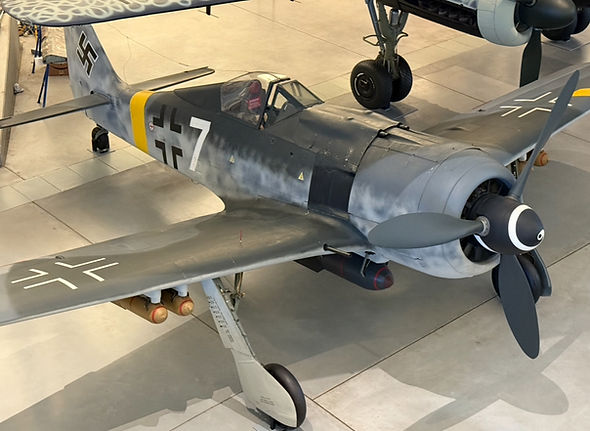Focke Wulf Fw 190
The operational debut of the Focke-Wulf 190 in August 1941 was an unpleasant surprise for the Royal Air Force.
Designer Kurt Tank's proposal for a radial engined fighter was at the time in Europe somewhat against the grain. Tank was encouraged by the designs he had seen emerge in the USA, and was convinced that the drag penalties of a radial design would not lead to an ineffective fighter.
After his original proposal for a fighter lost out to the Bf 109, that might have been the end of it, but the RLM soon determined that they needed a new type in development to fight alongside the 109, as the Allies would surely be working on their own new designs.
As a radial engined type, Tank's Fw 190 had the added benefit of not being subject to the availability of Daimler-Benz in-line engines, a production challenge that was already proving difficult for the manufacture of 109s and 110s. His design got the green light, and by 1941 she was ready to be fielded.
The RAF remained in late 1941 the only opposition in the west, primarily using the Spitfire Mk V on fighter sweeps over occupied France. Outclassed in every performance aspect save radius of turn, the appearance of the Fw 190 was an immediate challenge to the RAF's efforts to gain aerial superiority in the skies of north-western Europe.


Tank wanted his design to be a 'Cavalry Horse' as opposed to the 'Race Horse' of the Bf 109. He chose this analogy from his time in the trenches during the Great War, where the larger animals would be used to move heavy equipment at the front. In Tank's mind the Fw 190 needed to be a machine that could operate in an austere environment - a prescient view of conflict on the Eastern Front, where prepared airfields were few and far between and often denied to the Luftwaffe before they could be captured.
Just as the Bf 109 went through an extensive evolution in its life, the same was true of the Fw 190. While the former developed primarily from a short ranged escort fighter to a bomber destroyer, the latter became an accomplished fighter-bomber that would see the majority of its action in the East.
The Fw 190 F-8 (pictured here at the Steven F Udvar Hazy Center) is an excellent example, with no less than five hard points available to carry bombs.



